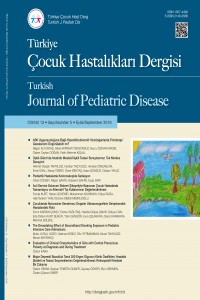Abstract
Hypertension, Obesity, Urinary Na/K, Urinary microalbumin/creatinine
References
- 1. Kotchen TA. Obesity-related hypertension: Epidemiology, pathophysiology, and clinical management. Am J Hypertens 2010;23:1170-8.
- 2. Lee S-G, Lee W, Kwon OH, Kim JH. Association of urinary sodium/ creatinine ratio and urinary sodium/specific gravity unit ratio with blood pressure and hypertension: KHANES 2009-2010. Clinica Chimica Acta 2013;424:168-73.
- 3. Thuesen B, Toft U, Buhelt L, Linneber A, Friedrich N, Nauck M, et al. Estimated daily salt intake in relation to blood pressure and blood lipids: the role of obesity. European Journal of Preventive Cardiology 2015;22:1567-74.
- 4. Geleijnse JM, Grobbee DE, Hofman A. Sodium and potassium intake and blood pressure change in childhood. BMJ 1990;300:899-902.
- 5. Bundak R, Furman A, Gunoz H, Darendeliler F, Bas F, Neyzi O. Body mass index references for Turkish children. Acta Paediatr 2006;95:194-8.
- 6. Montague CT, O’Rahilly S. The perils of portliness: Causes and consequences of visceral adiposity. Diabetes 2000;49:883–8.
Abstract
Amaç: Hipertansiyon patogenezinde diyetle aşırı sodyum ve düşük potasyum alımının ilişkisinin araştırılması.
Gereç ve Yöntemler: Çalışmaya 6-18 yaş arasında 56 obez normotansif, 41 obez hipertansif hasta ve kontrol grubu
olarak 29 sağlıklı çocuk çalışmaya dahil edilmiştir. Öğleden sonraki idrar örneklerinde sodyum/potasyum oranı ve Tanitabiyoempedans
yöntemi ile ayrıca total vücut yağ oranları değerlendirilmiştir.
Bulgular: Hipertansif 41 obez hastanın 10’u ≤10 yaş iken 31’i > 10 yaş olarak bulundu.
İnsülin düzeyleri ve HOMA-IR indeksleri, obez normotansif ve hipertansif gruplarda sırasıyla16.7±8.3ve 15.9±7.9 U/
ml, 4.4±3.4 ve5.3±3.4 olarak bulundu, istatistiksel olarak anlamlı fark saptanmadı. İdrar Na, K, Na/K ve mikroalbumin/
kreatinin oranlarında da kontrol, OHT ve ONT grupları arasında istatistiksel olarak anlamlı farklılık bulunmadı.
Sonuç: Artmış tuzlu ve yağlı yiyecek tüketimi, sedanter yaşam, hipertansiyon ve ilişkili hastalıklar açısından neden olabilecek
faktörlerdendir.
Keywords
References
- 1. Kotchen TA. Obesity-related hypertension: Epidemiology, pathophysiology, and clinical management. Am J Hypertens 2010;23:1170-8.
- 2. Lee S-G, Lee W, Kwon OH, Kim JH. Association of urinary sodium/ creatinine ratio and urinary sodium/specific gravity unit ratio with blood pressure and hypertension: KHANES 2009-2010. Clinica Chimica Acta 2013;424:168-73.
- 3. Thuesen B, Toft U, Buhelt L, Linneber A, Friedrich N, Nauck M, et al. Estimated daily salt intake in relation to blood pressure and blood lipids: the role of obesity. European Journal of Preventive Cardiology 2015;22:1567-74.
- 4. Geleijnse JM, Grobbee DE, Hofman A. Sodium and potassium intake and blood pressure change in childhood. BMJ 1990;300:899-902.
- 5. Bundak R, Furman A, Gunoz H, Darendeliler F, Bas F, Neyzi O. Body mass index references for Turkish children. Acta Paediatr 2006;95:194-8.
- 6. Montague CT, O’Rahilly S. The perils of portliness: Causes and consequences of visceral adiposity. Diabetes 2000;49:883–8.
Details
| Primary Language | English |
|---|---|
| Subjects | Internal Diseases |
| Journal Section | ORIGINAL ARTICLES |
| Authors | |
| Publication Date | September 23, 2019 |
| Submission Date | March 25, 2018 |
| Published in Issue | Year 2019 Volume: 13 Issue: 5 |
Cite
The publication language of Turkish Journal of Pediatric Disease is English.
Manuscripts submitted to the Turkish Journal of Pediatric Disease will go through a double-blind peer-review process. Each submission will be reviewed by at least two external, independent peer reviewers who are experts in the field, in order to ensure an unbiased evaluation process. The editorial board will invite an external and independent editor to manage the evaluation processes of manuscripts submitted by editors or by the editorial board members of the journal. The Editor in Chief is the final authority in the decision-making process for all submissions. Articles accepted for publication in the Turkish Journal of Pediatrics are put in the order of publication taking into account the acceptance dates. If the articles sent to the reviewers for evaluation are assessed as a senior for publication by the reviewers, the section editor and the editor considering all aspects (originality, high scientific quality and citation potential), it receives publication priority in addition to the articles assigned for the next issue.
The aim of the Turkish Journal of Pediatrics is to publish high-quality original research articles that will contribute to the international literature in the field of general pediatric health and diseases and its sub-branches. It also publishes editorial opinions, letters to the editor, reviews, case reports, book reviews, comments on previously published articles, meeting and conference proceedings, announcements, and biography. In addition to the field of child health and diseases, the journal also includes articles prepared in fields such as surgery, dentistry, public health, nutrition and dietetics, social services, human genetics, basic sciences, psychology, psychiatry, educational sciences, sociology and nursing, provided that they are related to this field. can be published.

